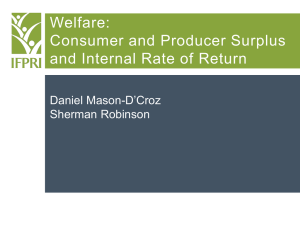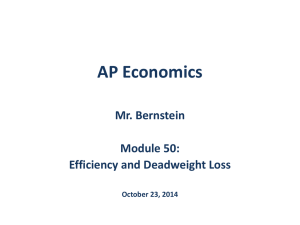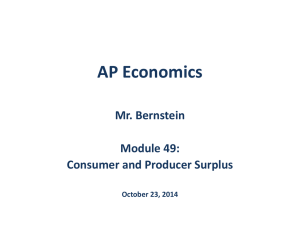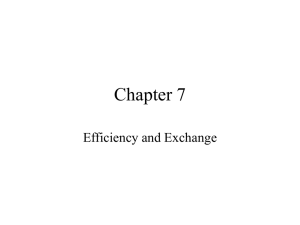Price - Dragonomics
advertisement
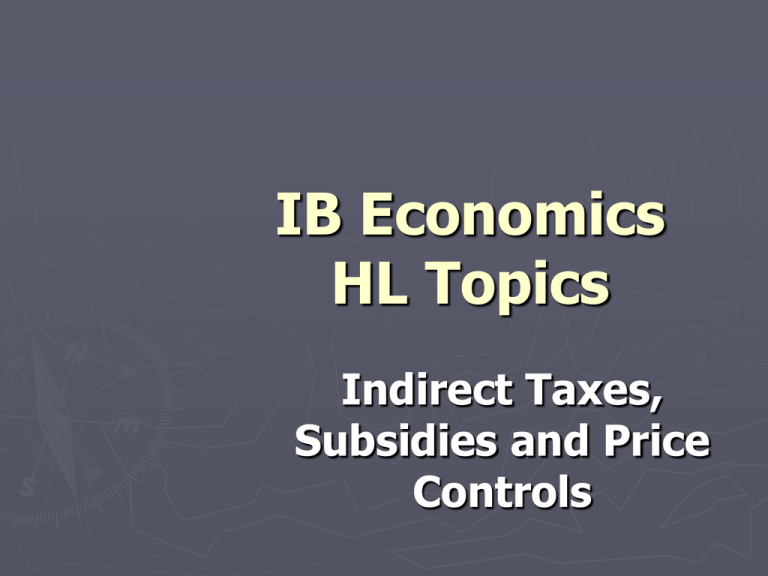
IB Economics HL Topics Indirect Taxes, Subsidies and Price Controls Tax Incidence (burden) ►Is a measure of the consequences of a tax on all the affected parties ►Tax impacts the profitability of any product, the degree may vary ►Whoever pays the tax suffers the tax burden Tax incidence: PED similar to PES Price S + tax S Ptax Pe P1 Tax burden of consumer Tax Revenue Tax burden of producer D Qtax Qe Quantity PED similar to PES ►Consumers and producers share the burden of tax equally ►Consumers pay more and receive less output ►Consumer and producer surplus decreased ►Market size was reduced from Qe to Qtax Tax incidence: PED > PES Price S + tax S Ptax Pe P1 Tax burden of consumer Tax Revenue Tax burden of producer D Qtax Qe Quantity PED > PES ► Demand is more elastic than supply ► Consumers are more responsive to price, and therefore less tolerant of price increases ► Producers pay more of the burden of the tax ► Government receives less revenue ► Market size decreases quite significantly, therefore employment is more likely to decline ► Deadweight loss is greater due to large decrease in quantity Tax incidence: PED < PES Price S + tax S Ptax Pe P1 Tax burden of consumer Tax Revenue producer D Qtax Qe Quantity PED < PES ►Consumers are relatively indifferent to price changes ►Consumers tax burden is greater than producers ►Government receives more revenue ►Market size decreases relatively little, therefore employment is less affected ►Deadweight loss is smaller PED vs PES Summary ►The more elastic the demand relative to supply, the greater the burden paid by producers, the greater the deadweight loss, and the smaller the government revenue ►The more inelastic the demand relative to supply, the greater the burden paid by consumers, the smaller the deadweight loss, and the greater the government revenue ►Government will place indirect taxes on products that have relatively inelastic demand The demand will change in smaller proportion, gain high revenue and yet not cause a large fall in employment Size of Deadweight Loss ► The deadweight loss of the tax will depend upon two factors: The size of the tax The reduction in the quantity sold ► The reduction in the quantity sold will depend upon the elasticity of demand and supply The more elastic demand or supply is the larger the deadweight loss will be If either demand or supply is price inelastic then the deadweight loss will be small and could be zero if perfectly inelastic (no change in the quantity sold and consumed) Total Welfare before Tax Price A + B + C = Consumer Surplus (before tax) Price buyers = PB pay S = MC A B C Price without tax = P1 Price sellers = PS receive E1 E D E1 maximizes Total Welfare F D = MB Producer Surplus = D + E + F 0 Q2 Q1 (before tax) QTY Tax Affect on Total Welfare Price Area C + E is a complete loss to Society: (DEADWEIGHT LOSS) Price buyers = PB pay S = MC A B C Price without tax = P1 Price sellers = PS receive E D F D = MB B+D = Tax Revenue 0 Q2 Q1 Quantity Tax incidence and Linear Function HL Page 107 Exercise Additional graphs Consumer Surplus Price Consumer Surplus Maximum Willingness to Pay for Qo Po What is paid D Qo Quantity Change in Consumer Surplus: Price Increase Price New Consumer Surplus Original Consumer Surplus Loss in Surplus: Consumers paying more P1 Po Loss in Surplus: Consumers buying less D Q1 Qo Quantity Producer Surplus Price S Producer Surplus Po What is paid Minimum Amount Needed to Supply Qo Qo Quantity Consumer and Producer Surplus Price Consumer Surplus Po S Producer Surplus D Qo Quantity Loss in Efficiency Too High of Price (Price Floor) Price Deadweight Loss Lost Consumer Surplus New Consumer Surplus S PH Po Lost Producer Surplus New Producer Surplus D QL Qo Quantity Loss in Efficiency Too Low of Price (Price Ceiling) Price Deadweight Loss Lost Consumer Surplus S New Consumer Surplus Po Lost Producer Surplus PL New Producer Surplus D QL Qo Quantity Loss in Efficiency Taxation STax Price Tax New Consumer Surplus Lost Consumer Surplus PD Tax Revenues S Po Deadweight Loss Lost Producer Surplus PS New Producer Surplus D QL Qo Quantity Subsidy Loss in Efficiency Subsidy Price S Gain in Producer Surplus New Consumer Surplus PS SSub Subsidy Gain in Consumer Po Surplus PD New Producer Surplus Deadweight Loss D Subsidy Cost Qo QH Quantity


